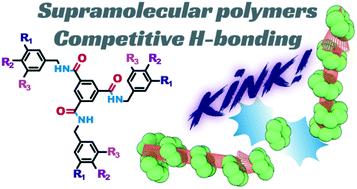Competitive hydrogen bonding in supramolecular polymerizations of tribenzylbenzene-1,3,5-tricarboxamides†
Abstract
Despite numerous reports on nucleated supramolecular polymerization, the molecular origin of the properties of these supramolecular polymers remains overlooked. Here, the formation of fibers formed by self-assembly of N,N′,N′′-tris(alkoxybenzyl)benzene-1,3,5-tricarboxamides (benzyl-BTAs) has been studied using both simulations and experimental techniques. The simulations show that the fibers exhibit a dynamic behavior with stacking defects that appear and propagate differently depending on the BTA molecular structure. To validate theoretical results, a library of eight benzyl-BTAs has been synthesized to compare their supramolecular polymerizations both in the bulk and in apolar solvents. We show that the molecular organization of monomers and dynamics of supramolecular polymers strongly depend on the number and position of the alkoxy substituents on peripheral phenyl rings. By combining theoretical results with experimental measurements, we elucidate the likely role of competitive hydrogen bonding between the central amides and peripheral ether moieties on the stacking behavior of BTAs and the dynamics of structural defects in supramolecular polymers. Our findings open up new design rules for these dynamic materials.



 Please wait while we load your content...
Please wait while we load your content...